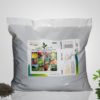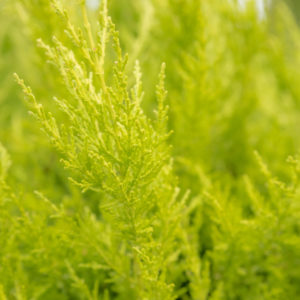Juniperus horizontalis ‘Prince of Wales’
€22.00
Frequently Bought Together


Description
Quick Facts
- Common Name: Prince of Wales Juniper, Creeping Juniper
- Botanical Name: Juniperus horizontalis ‘Prince of Wales’
- Plant Type: Evergreen conifer ground cover shrub
- Mature Height: 10-15cm
- Mature Spread: 2-3m
- Flowering Period: Insignificant flowers
- Flower Colour: N/A (grown for foliage)
- Foliage: Blue-green scale-like foliage turning purple-bronze in winter
- Hardiness: RHS H7 (fully hardy throughout UK and Ireland)
- Soil Requirements: Well-drained soil; tolerates poor, sandy, and dry soils
- Aspect: Full sun to partial shade
- Maintenance: Very low
Description
Experience the breathtaking beauty of Juniperus horizontalis ‘Prince of Wales’, one of the most elegant and versatile ground cover conifers for gardens, where dense carpets of blue-green foliage hug the ground creating living tapestries of year-round colour and texture that suppress weeds, cascade over walls, and bring effortless elegance to challenging positions with exceptional reliability and minimal maintenance. This exceptional cultivar offers remarkable qualities—beautiful blue-green to bright green scale-like foliage creating dense mats of soft texture and cool colour throughout spring and summer, spectacular winter transformation when foliage develops rich purple-bronze to plum tones adding seasonal interest and warm winter colour, extremely low prostrate habit growing only 10-15cm tall while spreading 2-3m wide creating perfect horizontal ground cover that hugs contours and cascades gracefully over edges, outstanding drought tolerance and adaptability once established thriving in poor dry soils, slopes, gravel gardens, and challenging positions where many plants struggle, and exceptional hardiness withstanding cold winters, exposed positions, and urban pollution making it completely reliable throughout temperate climates, making this one of the most practical and beautiful choices for adding year-round evergreen ground cover, weed suppression, and low-maintenance elegance to slopes, rock gardens, borders, and anywhere effortless horizontal structure with seasonal colour change is desired.
Throughout the seasons, this captivating conifer displays its characteristic foliage—the leaves are tiny scale-like structures (juvenile foliage, typical of mature Juniperus horizontalis) tightly packed along prostrate branches creating dense soft texture. During spring and summer, the foliage is beautiful blue-green to bright green with slightly glaucous (blue-grey) tones creating cool refreshing colour that complements virtually every garden colour scheme. The branches grow horizontally, radiating outward from the centre in flat layers that overlap creating dense weed-suppressing coverage—the growth habit is completely prostrate with branches lying flat against the ground or cascading over edges without any upward growth. Individual branches can extend 50-80cm annually once established, creating rapid coverage. The foliage has soft appearance and pleasant texture (not prickly like some junipers), making it comfortable to work around. In autumn and winter (October-March), the foliage undergoes beautiful transformation developing rich purple-bronze to plum-purple tones particularly on exposed outer growth creating stunning winter colour and seasonal interest—this winter colour is most intense in cold weather and full sun positions. In spring, the foliage returns to blue-green as temperatures warm. The overall effect is like a living carpet or tapestry that changes with the seasons—cool blue-green in summer, warm purple-bronze in winter. The extremely low prostrate habit makes this perfect for ground cover, with mature plants forming dense mats only 10-15cm tall but spreading 2-3m wide creating substantial horizontal coverage. The branches cascade beautifully over walls, edges, and slopes creating graceful waterfalls of foliage.
Native to North America where Juniperus horizontalis grows wild across northern regions from Alaska to Newfoundland, typically on rocky slopes, sandy soils, and exposed positions, this species has been cultivated for centuries for ground cover and ornamental use. The species name ‘horizontalis’ perfectly describes the completely prostrate horizontal growth habit. ‘Prince of Wales’ is a superior cultivar selected in Canada specifically for its bright blue-green summer foliage, excellent purple-bronze winter colour, dense compact growth, and exceptional garden performance—it’s considered one of the finest forms of creeping juniper for ornamental use. The cultivar name honours the Prince of Wales, reflecting its prestigious status among ground cover conifers. Hardy to RHS H7, this exceptionally robust plant thrives throughout UK and Ireland with complete reliability, tolerating severe cold (to -20°C or below), exposed positions, coastal conditions, and urban pollution. Moderate to fast growth rate once established, spreading 30-50cm annually and reaching full coverage within 3-5 years. Particularly valuable for extremely low maintenance requirements—once established, this plant requires virtually no care and thrives on neglect, outstanding weed suppression due to dense growth habit that smothers weeds and prevents germination, exceptional drought tolerance once established making it perfect for dry slopes and gravel gardens, and beautiful seasonal colour change from blue-green in summer to purple-bronze in winter providing year-round interest.
Create stunning compositions by planting as ground cover on slopes and banks where its prostrate habit prevents erosion and creates maintenance-free coverage that eliminates mowing and weeding, using to cascade over walls, raised beds, and edges where the horizontal branches create graceful waterfalls of foliage, or positioning in rock gardens and gravel gardens where the low habit and drought tolerance excel creating evergreen structure among rocks and gravel. Exceptional in contemporary gardens as living mulch or ground cover creating horizontal planes and modern minimalist aesthetic, Mediterranean-style gardens where the blue-green colour and drought tolerance fit perfectly with the aesthetic, or coastal gardens where the salt tolerance and wind resistance make it reliable choice for seaside positions. Works beautifully planted in groups or drifts for substantial coverage—space plants 1-1.5m apart and they will merge within 3-4 years creating continuous carpet, as underplanting beneath taller shrubs and trees where the low habit and shade tolerance allow it to thrive beneath canopy, or combined with contrasting textures—upright conifers (Juniperus scopulorum ‘Skyrocket’, Taxus baccata ‘Fastigiata’) for vertical-horizontal contrast, ornamental grasses (Stipa, Festuca, Pennisetum) for soft textural contrast, or architectural perennials (Sedum, Sempervivum, Euphorbia) for layered planting. Also magnificent in large containers and troughs where branches cascade over edges, as edging along paths and driveways where the low habit won’t obstruct views or access, or in parking areas and commercial landscapes where low maintenance and reliability are essential. Perfect for adding year-round evergreen ground cover, weed suppression, and low-maintenance elegance to slopes, rock gardens, borders, and anywhere effortless horizontal structure with seasonal colour change is desired.
Caragh Garden Notebook
Planting: Space plants 1-1.5m apart for ground cover that will merge within 3-4 years creating continuous carpet, or 2m apart for individual specimens that will form substantial mats. Plant container-grown specimens year-round, though spring (March-May) or autumn (September-October) is ideal for best establishment. Choose position in full sun for best foliage colour and most intense winter purple-bronze tones—tolerates partial shade but growth may be slightly slower and winter colour less intense. Thrives in well-drained positions including slopes, banks, raised beds, and gravel gardens—excellent for challenging dry positions. Dig planting hole slightly larger than root ball and same depth. This plant thrives in lean conditions, so minimal soil improvement is needed—avoid over-enriching soil. Plant at same depth as in container, ensuring root ball is level with surrounding soil. Backfill with excavated soil, firming gently. Water thoroughly after planting. Mulch lightly with gravel or bark around plants (not over foliage) to suppress weeds until plants establish coverage—once established, the dense growth provides its own weed suppression. Water regularly during first growing season to establish root system, though established plants are remarkably drought-tolerant. Position where the prostrate habit can spread freely or cascade over edges—avoid planting where upward growth is desired as this plant grows only horizontally.
Soil Preparation: Tolerates remarkably wide range of soil types including sandy, loamy, clay, chalky, and poor soils—this is one of the most adaptable conifers for challenging conditions. Prefers slightly acidic to neutral pH (5.5-7.0) but tolerates alkaline conditions. CRITICAL: Requires well-drained soil—avoid waterlogged or poorly drained soils which cause root rot and foliage browning, particularly in winter. Thrives in poor to moderately fertile soils—rich fertile soils are unnecessary and can cause looser growth. Excellent for dry slopes, sandy banks, and gravel gardens where drainage is excellent. Improve heavy clay soils by incorporating grit or gravel to improve drainage. Light sandy soils are ideal and require no improvement. Once established, this plant is exceptionally drought-tolerant and thrives in dry conditions—deep watering during establishment is important, but mature plants rarely need watering. Mulch lightly to suppress weeds during establishment, though once plants form dense coverage, mulching is unnecessary. Best growth and foliage colour occur in full sun with well-drained soil (even poor or sandy)—these conditions produce dense compact growth and most intense winter colour.
Container Growing: Excellent for container growing, particularly in large containers, troughs, and raised planters where branches can cascade over edges! Use free-draining compost (mix soil-based compost with extra grit for improved drainage), choose containers with drainage holes, and position in full sun. Water regularly during growing season allowing compost to dry slightly between waterings—avoid overwatering which causes root rot. Feed sparingly with half-strength balanced fertiliser once in spring—avoid overfeeding which causes loose growth. Trim lightly if needed to control spread. Perfect for cascading over edges of containers, window boxes, and raised planters creating graceful waterfalls of foliage.
Seasonal Care: Requires virtually no maintenance—this is one of the most low-maintenance plants available! No pruning needed—the naturally prostrate habit develops without intervention and maintains perfect form. Can trim lightly in spring (April-May) if needed to control spread or shape plants, removing wayward branches or trimming edges, but avoid cutting back into old bare wood as junipers do not regenerate from old growth—only trim current season’s green growth. Remove any dead or damaged branches as needed. No fertilising needed—this plant thrives in lean conditions and excessive fertility causes loose growth. No watering needed once established—this plant is exceptionally drought-tolerant and thrives on neglect. Watch for juniper scale insects (small brown bumps on foliage—treat with horticultural oil in spring) and spider mites in hot dry conditions (spray with water to increase humidity). Generally pest and disease free with excellent air circulation and appropriate positioning. Phytophthora root rot can occur in waterlogged soils—ensure excellent drainage to prevent. The seasonal colour change from blue-green to purple-bronze is reliably spectacular and requires no intervention!
Propagation: Can be propagated from semi-ripe cuttings taken in late summer (August-September) with moderate success—take 8-12cm cuttings from current season’s growth, remove lower foliage, dip in rooting hormone, and insert into free-draining compost. Rooting takes 8-12 weeks and success rate is moderate. Can also be layered—pin branches to soil and they will root where they touch ground, then separate rooted sections. Home gardeners can propagate this plant, though nursery-grown specimens provide more immediate coverage and guaranteed quality.
This spectacular beauty is absolutely breathtaking—one of the finest ground cover conifers available! That beautiful blue-green foliage creating dense carpets only 10-15cm tall while spreading 2-3m wide is absolutely stunning—perfect horizontal ground cover! Spectacular winter transformation to rich purple-bronze tones adding seasonal interest and warm winter colour. Extremely low prostrate habit—branches hug ground and cascade gracefully over edges creating living tapestries. Outstanding drought tolerance once established—thrives in poor dry soils and challenging positions! Exceptional hardiness (RHS H7)—completely reliable throughout UK and Ireland! Virtually no maintenance required—thrives on neglect once established! Excellent weed suppression. Perfect for slopes, rock gardens, cascading over walls, ground cover, gravel gardens, and anywhere you want year-round evergreen coverage with seasonal colour change and effortless elegance. Excellent in containers! Pure low-maintenance magnificence and living carpet beauty!





